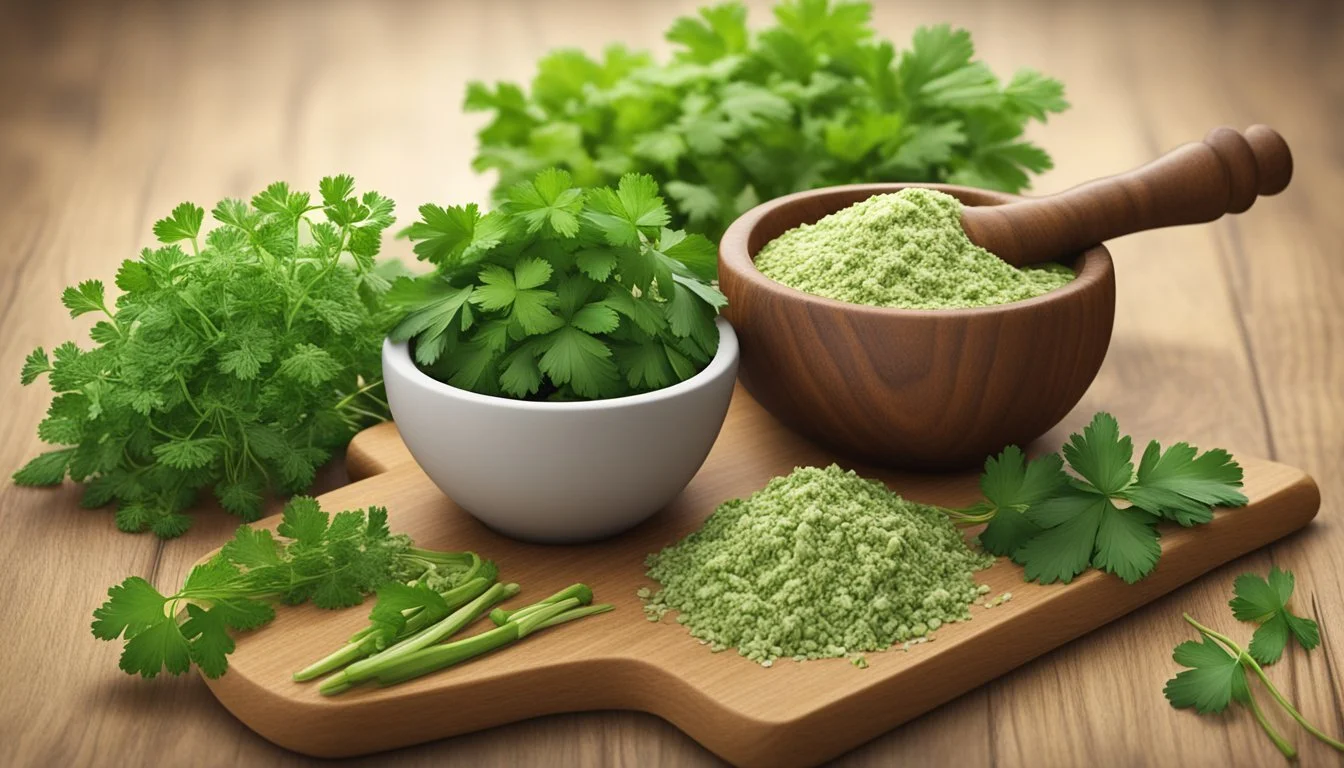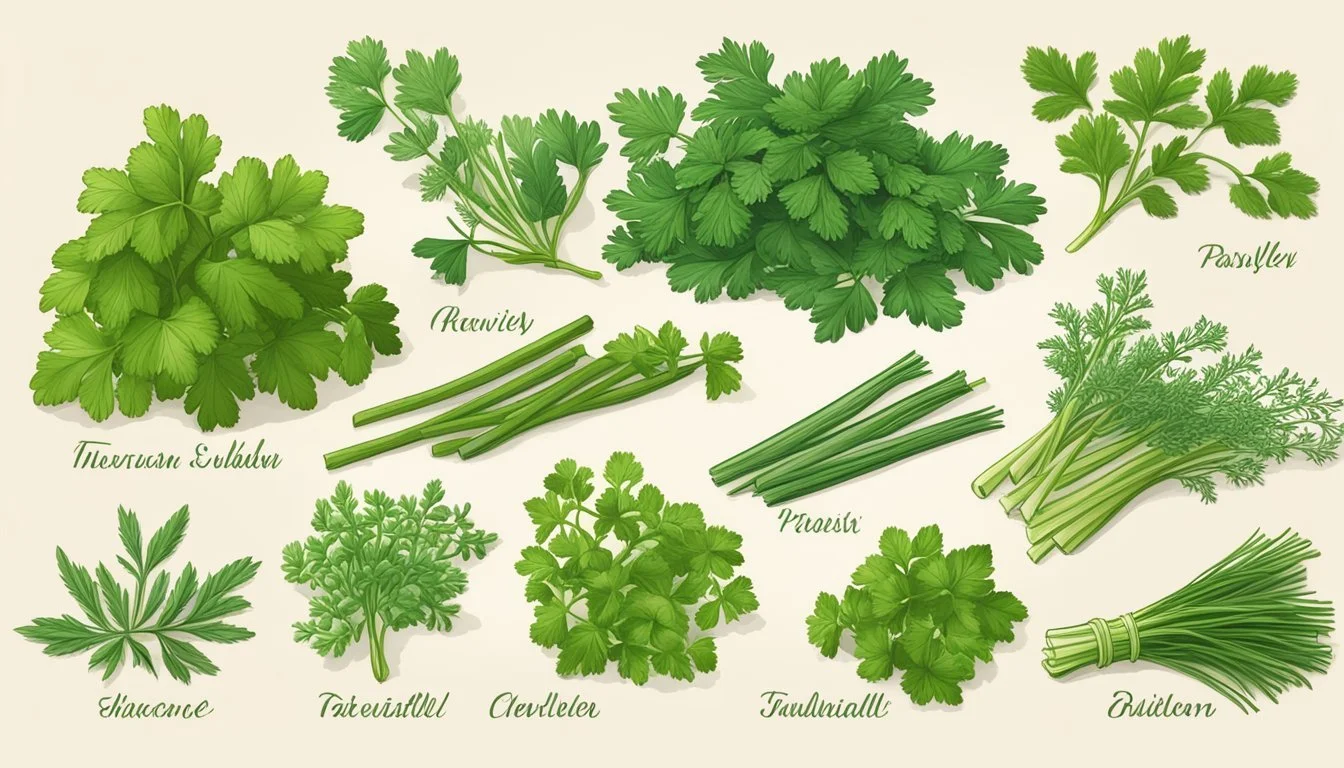Chervil Substitutes
Top Alternatives for Your Recipes
Chervil is a delicate herb often used in French cuisine, prized for its light and slightly anise-like flavor. Its role in kitchen applications is significant, as it contributes a distinct, yet subtle, taste essential to the balance of certain dishes. Due to its nuanced flavor profile, chervil is not just a garnish but a component that can influence the overall palate of culinary creations. It is a staple in the classic French herb mixture known as 'fines herbes' and is often used in sauces like Béarnaise.
Despite chervil's importance, it is not always readily available, and cooks may need to find a suitable replacement when preparing recipes that call for it. Several herbs offer a similar flavor profile and can be used as substitutes without drastically altering the taste of the dish. When selecting an alternative, it is crucial to consider the herb's intensity and how it will interact with the other ingredients within the recipe. Balancing flavors and maintaining the integrity of the classic dishes that feature chervil is achievable with a thoughtful choice of substitute.
Understanding Chervil
Chervil is an integral herb in French cooking, known for its delicate flavor and multifaceted uses in culinary applications.
Culinary Uses of Chervil
Chervil plays an essential role in French cuisine, elevating the taste of various dishes through its inclusion. It is commonly used in sauces and soups due to its ability to impart a subtle elegance without dominating the dish's flavor profile. The herb is also a staple in salad preparations, where its delicate texture can be fully appreciated. Additionally, chervil acts as a visually appealing garnish, adding both color and taste to plates.
Chervil's Flavor Profile
The distinctive taste of chervil can be described as a mild anise-like flavor, often compared to licorice, with a lightness that prevents it from overwhelming other ingredients. This makes it a versatile component in cooking, especially in the well-known French herb mixture, fines herbes, which includes parsley, chives, tarragon, and chervil itself.
Nutritional Benefits
Chervil is not only prized for its culinary versatility, but also for its nutritional properties. It is a good source of various vitamins and minerals, contributing to a balanced diet. Some of the key nutrients found in chervil include:
Vitamins: Especially high in vitamin A, which is crucial for vision, immune system, and skin health.
Minerals: Provides minerals such as potassium and magnesium.
In summary, chervil is a delicate herb with licorice-like undertones used extensively in French cooking, from enhancing sauces and soups to garnishing salads. It complements other flavors without outshining them and offers nutritional benefits, including essential vitamins and minerals.
Common Chervil Substitutes
Chervil is an aromatic herb often used in French cuisine, prized for its delicate flavor reminiscent of anise. When chervil is unavailable, several substitutes can closely mimic its taste and complement various dishes effectively.
Dill as a Substitute
Dill offers a unique tangy flavor that pairs well with fish and egg dishes. While it has a stronger taste compared to chervil, it's often recommended to use half the amount of dill when substituting to avoid overpowering the dish.
Tarragon's Compatibility
Tarragon, with its slight licorice flavor, makes an excellent chervil substitute, especially in recipes like chicken, butter sauces, and the classic bearnáise sauce. It's best used in cooking rather than as a garnish due to its bold taste.
Fennel and Its Uses
Fennel, with its anise-like flavor, is versatile in Mediterranean and Indian cuisines. Fennel leaves work as a chervil substitute in dishes like soups, sausages, and salads. Use it fresh or dried to impart a sweet, licorice flavor.
The Versatility of Parsley
Italian parsley, or flat-leaf parsley, is robust and less distinct in flavor but can closely match chervil when used in garnishing and salad dressings. It's a versatile herb that complements a wide range of recipes without clashing with other ingredients.
Cilantro's Distinct Taste
Cilantro stands out with its fresh, lemony profile that is a staple in salsas and pesto, and is a mainstay in Mexican cuisine. Despite its distinct taste, it can serve as a chervil substitute, particularly in bold and zesty recipes.
Anise's Sweet Essence
Anise is excellent for baking and desserts and can be used as a chervil substitute due to its sweet, anise flavor. It's potent, so moderation is key when incorporating into savory dishes to achieve the subtlety of chervil.
Chives for a Milder Touch
Chives can be a flavorful yet milder alternative to chervil, ideal for potatoes, omelets, and as a fine touch in baked goods. They offer a more subdued flavor that won't dominate the dish but still provides an appealing green garnish.
Workarounds For Specific Dishes
When chervil is not available, choosing an appropriate substitute depends on the dish being prepared. Different herbs can complement and enhance the flavors of specific foods, ensuring that the dish maintains its intended profile.
Seafood and Fish Enhancements
For seafood and fish, an herb with a light touch is preferred to not overpower the delicate flavors. Dill is an ideal chervil substitute here; it provides a unique tangy flavor without dominating the dish.
Dill: Use in a 1:1 ratio with chervil.
Salads and Dressing Mixes
Salads and dressing mixes benefit from substitutes that mirror chervil's mild profile. Fennel fronds offer a slight anise flavor that works well in dressings. Another good alternative is tarragon, which can be particularly complementary in dressings with an herby profile.
Fennel fronds: Use in place of chervil as a dressing ingredient or garnish.
Tarragon: A stronger flavor, so start with half the amount of chervil called for and adjust to taste.
Soups and Stews Accompaniments
When preparing soups and stews, substitutes that offer a complex yet gentle flavor like that of chervil can greatly enhance the dish.
Parsley: A common and versatile herb, makes a good substitute in a pinch.
Cilantro: While it has a distinctive taste, it should be used cautiously and in smaller quantities than chervil to not overpower the dish.
Egg and Cheese Combinations
In dishes that feature egg and cheese, the substitute for chervil should complement these rich flavors without competing with them.
Chives: Its mild onion flavor pairs well with egg dishes.
Basil: Can bring a fresh perspective to cheese-centric recipes. Use in a similar quantity to chervil.
Growing and Storing Chervil
Growing chervil successfully requires attention to its planting environment and care, while storing it properly can significantly extend its shelf life and maintain its delicate flavor.
Cultivating Chervil at Home
Chervil, often referred to as French parsley, thrives in cool conditions and can commonly be planted in early spring or late summer to avoid the heat. For home gardeners, chervil requires moist, well-drained soil with partial shade. They must ensure that the herb garden doesn’t dry out or get too hot, which can cause the plant to bolt and develop an undesirable flavor.
Seasonality: Plant in early spring or late summer
Soil: Moist, well-drained
Sunlight: Partial shade, 4 hours of sunlight a day
One can start chervil indoors on a windowsill planter or outside in an outdoor garden, considering it has a long taproot which means it needs deep pots if grown in containers. Gardening enthusiasts can find chervil at most grocery stores in the seed section, or it may be available in nurseries during the planting season.
Storing Chervil for Freshness
To maximize shelf life and maintain its vibrant flavor, chervil should be stored in the refrigeration unit of a kitchen. One can place the chervil in a plastic bag or wrap it in a damp paper towel before refrigerating to prevent wilt. Chervil's shelf life is relatively short because it is a delicate herb, so using it fresh is ideal. If one has an abundance of chervil, it can be preserved through freezing or it can be dried, but one should note that dried chervil has a less pronounced flavor than its fresh counterpart.
Refrigeration: Store in a plastic bag or wrapped in damp paper towel
Preservation Method: Freezing (preferred) or drying
Shelf Life: Best when used fresh; limited when refrigerated
It is important to note that while chervil is more commonly used fresh, the proper storage techniques allow one to enjoy its delicate anise-like flavor outside its typical seasonality.
Exploring Chervil in World Cuisines
Chervil is a distinct, delicate herb used in various global cuisines to add a mild, anise-like flavor to dishes. Noted for its feathery leaves, it is a classic component in French cooking and is gaining popularity in Scandinavian recipes.
Chervil in French Gastronomy
In France, chervil is a staple herb, especially in fines herbes, a herb mixture pivotal to French cuisine that also includes parsley, tarragon, and chives. This blend is often used to season poultry, fish, and salads. Chervil enhances the flavors of dishes such as Ravigote sauce, commonly served with cold meats. It's also a beloved garnish for soups and a flavorful addition to omelets and cheese dishes.
French Cooking with Chervil:
Poultry: Used as a seasoning in stuffing or as part of a rub
Fish and Seafood: Sprinkled on as a garnish or incorporated into sauces
Salads: Often found in vinaigrettes or as a fresh topping
Pasta Dishes (What wine goes well with pasta dishes?): Adds a subtle hint of anise to creamy sauces
Chervil's Role in Scandinavian Dishes
Scandinavian cuisine embraces chervil, particularly in fish and seafood dishes. It pairs exceptionally well with salmon, whether the fish is grilled, smoked, or served in a creamy sauce. Chervil's light, fresh flavor complements the hearty and often rich flavors found in Scandinavian cooking, such as those in pickled or brined dishes. Dill, a common herb in the region, can be used to substitute chervil when needed.
Scandinavian Dishes Featuring Chervil:
Salmon: As a garnish or included in marinades
Salads: Makes a flavorful addition to a simple, fresh salad
Cauliflower and Mushroom: In purees or sauces to brighten earthy dishes
Chervil Influences in Other Cuisines
While not as prominent as in French and Scandinavian cuisines, chervil's special flavor is also utilized in other culinary traditions. It is a subtle touch in mixed green salads and pasta dishes, harmonizing with ingredients rather than overpowering them. When chervil is not available, ingredients like parsley and cilantro can be used to mimic its taste, especially in salads and as a garnish.
Substitutes in Various Cuisines:
Parsley: A fine substitute for garnishing and flavoring, particularly in salads
Cilantro: Offers a fresh taste similar to chervil in some spicy and savory dishes
Dill: Works as a chervil stand-in for fish and seafood-centric recipes
Chervil continues to be a versatile herb across diverse cuisines, lending its unique flavor to many traditional and modern recipes.
Alternatives to Fresh Chervil
When fresh chervil is unavailable, cooks can turn to several suitable alternatives. These options help maintain a mild flavor profile characteristic of chervil and ensure culinary dishes retain their intended essence.
Using Dried Chervil
Dried chervil might be the closest substitute in terms of flavor and aroma. However, its texture can be different from fresh chervil, and it is less potent. For every tablespoon of fresh chervil, one can use one teaspoon of dried chervil. To best preserve its flavor, add it towards the end of the cooking process.
Substitutes for Chervil in Cooking
Several herbs can replicate the delicate taste of chervil:
Parsley: Also a member of the parsley family, flat-leaf or Italian parsley offers a similar bright taste.
Tarragon: With a bittersweet taste and hints of anise, tarragon's potency requires one to use it sparingly.
Cicely: Sweet cicely imparts a flavor reminiscent of anise, similar to chervil.
In dishes, these substitutes maintain a mild flavor suitable for cooking applications like garnishing or adding to sauces.
Herb Blends and Mixes
Classic fines herbes is a French blend containing parsley, chives, tarragon, and sometimes chervil itself. This mix is excellent to impart a subtle and sophisticated flavor to dishes such as omelets or poultry.
For a different twist, incorporating basil can create a versatile pesto blend, while mixing select dried herbs can effectively flavor an oyster sauce without the need for fresh chervil. These blends cater to both the fragrance and flavor requirements in various culinary preparations.
Chervil Substitutes in Specialty Dishes
In specialty dishes where chervil is traditionally used, such as in fine herb blends for fish, salads, and sauces, substitutes must be chosen to maintain the integrity of the original flavor profile.
Vegetarian and Vegan Alternatives
For vegetarian and vegan cooking, choosing the right chervil substitute is crucial to enhance the dish without overpowering other delicate flavors. Mitsuba, also known as Japanese parsley, is an ideal substitute in recipes like stir-fries and soups. Its flavor is similar to chervil and can be employed in a 1:1 substitution.
Soups & Salad: For creamy vegetable soups and fresh salads, Italian flat-leaf parsley imparts a bright, slightly peppery flavor. When making dressings, adding lemon juice alongside parsley can mimic chervil’s subtle notes.
Pasta Dishes: In pasta dishes that typically use chervil, fresh dill can be cautiously introduced, with a half-tablespoon of dill to replace one tablespoon of chervil, especially in recipes that involve spinach or other green vegetables.
Chervil in Meat-Based Recipes
When it comes to meat-based recipes, such as those involving poultry, pork, or casserole dishes, it's important to match the distinct taste chervil brings without changing the core essence of the dish.
Poultry & Pork: Tarragon, with its bittersweet flavor and hint of licorice, serves well with poultry and pork dishes. Its potent flavor means it should be used sparingly; a small amount goes a long way.
Casseroles & Sauces: Another alternative for meat-centric casseroles and sauces is dried chervil itself, which retains much of the herb’s original flavor profile and is suitable when fresh chervil is unavailable.







